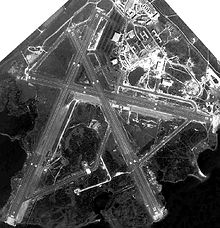Naval Auxiliary Air Station Charlestown
The Naval Auxiliary Air Station Charlestown (NAAS Charlestown) was a military airfield and missile launch site near the city of Charlestown , Rhode Island . The airfield operated from 1942 to 1974. Today parts of the Ninigret National Wildlife Refuge are located on part of the site .
history
After the United States entered World War II, bases were needed for the training of soldiers. Therefore, appropriate airfields were created by the US Navy. With the construction of the military base in Quonset Point , the Naval Auxiliary Air Station was built as a training and alternative airfield near Charlestown from April 1942. The training of the night fighter and bomber units, as well as the pilots for the carrier aircraft, took place at the airfield, which was put into operation on May 15, 1943. After the expansion was completed in 1944, over 220 aircraft could be accommodated at the airfield. The airfield also served as a base for a night bomber fleet. From 1945 NAAS Charlestown was the base of a Navy Air Navigation Project. In this project, navigation aids and flight control systems were developed and tested. On March 31, 1947, the stationed unit was withdrawn and the airfield served from then on primarily as an alternative and emergency landing airfield for the Quonset Point base.
Drag racing events were held in the late 1950s / early 1960s . Two hangars were demolished by 1962.
From 1965 the airfield was also used as a rocket launch site. The largest rocket was a Nike Tomahawk sounding rocket . This was started on May 20, 1965 to observe a solar eclipse .
In 1973, operations at the airfield ceased and on January 30, 1974, it was shut down. Shortly afterwards, New England Power plans to build a nuclear power station on the site. After the failure of these plans, the area was assigned to the city of Charlestown (0.9 km²) and the Ministry of the Interior (1.6 km²). The Department of the Interior is converting their area into the Ninigret National Wildlife Refuge, managed by the United States Fish and Wildlife Service . All hangars were demolished. In 1987, the asphalt of the runways was partially removed to enable renaturation. As a result, contaminated sites, including ammunition, were removed.
There are also tennis courts, a racing bike track and a memorial for the fallen soldiers of the airfield on the grounds of the city of Charlestown.
On November 18, 1999, the Florida Spaceport Authority (SPFLA) launched a Viper 3A for comet observation. The rocket reached an altitude of 90 kilometers.
location
The airfield is located southwest of Charlestown on Ninigret Pond. US Highway 1 runs north . It has a size of around 2.6 km² (631 acres).
Structural systems
The airfield had three asphalt runways with a width of 200 feet (60.96 m) and lengths of 5800 feet (1767.84 m), 5200 feet (1584.96 m) and 4800 feet (1463.04 m) ).
A massive tower with hangar as well as further separately standing hangars (partly made of wood) were built. Then there were the other necessary facilities for such an airfield.
Web links
- Abandoned & Little-Known Airfields: Rhode Island. Retrieved July 30, 2019 .
- US Army Corps of Engineers: Ordnance and Explosives Archives Search Report for the former Naval Auxiliary Landing Field Charlestown, Rhode Island . 1999 ( charlestownri.org [PDF]).
- Charlestown in the Encyclopedia Astronautica (English)
Individual evidence
- ↑ 12 Jun 1960, 116 - Hartford Courant at Newspapers.com. Retrieved July 31, 2019 .
- ^ Charlestown Naval Auxiliary Landing Field Memorial, a War Memorial. Retrieved July 30, 2019 .
Coordinates: 41 ° 22 ′ 5.2 ″ N , 71 ° 40 ′ 1.6 ″ W.
